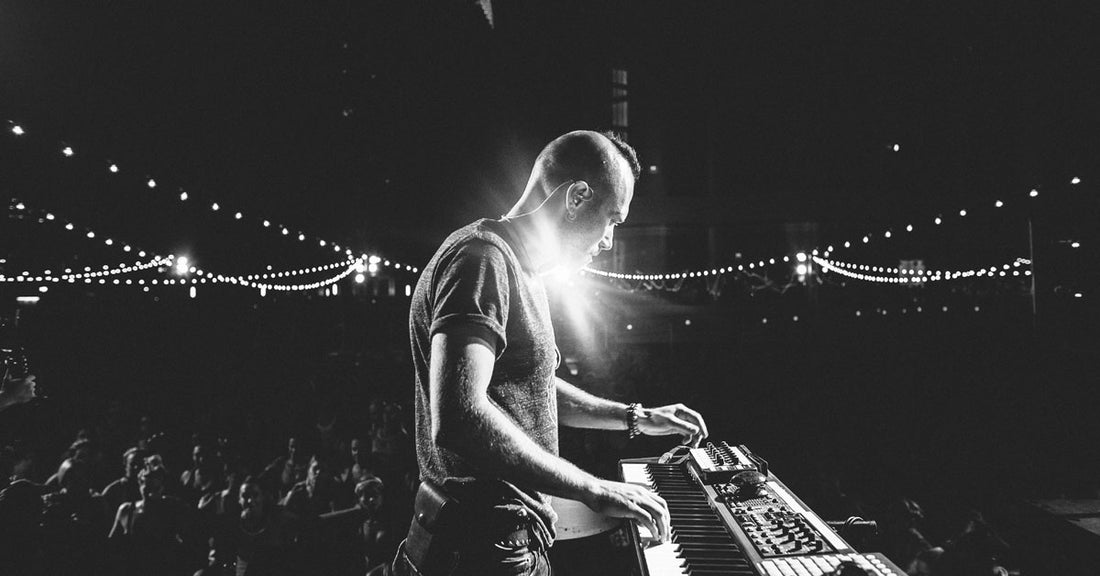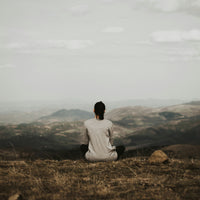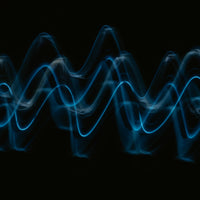As he walked out on stage to headline the Music as Medicine LA event, surrounded by hundreds of adoring followers seated on yoga mats—many under the effects of psilocybin—Krishna Oswalt, or the artist known as East Forest, opened with an icebreaker:
"Snoring doesn't really add to the vibe."
I’m no music expert, not much of a concert-goer really, but it’s my understanding that if an entertainer needs to explicitly ask the audience to stay awake, it’s not a good sign for things to come.
But, judging by the line that wrapped around the corner just an hour prior, the audience seemed psyched for this soporific showcase. Self-aware spiritual types adorned fuzzy onesies, cashmere blankets and backpacks with pillows spilling out the top. While standing there in a blank T-shirt, unremarkable pants and a flannel, it occurred to me that I might be walking into a 300-person cuddle puddle.
Admittedly, I was suspicious of Oswalt. I’m suspicious of anyone who speaks of “a great transition” and implores us to “ignite a revolution in our hearts” as he does on his 'About' page. The following day I had a podcast interview scheduled with Oswalt, but until then, I tried to keep my mind as open as his acolytes in line.
The event was curated by the Canadian psychedelic company, Numinus, held at Lighthouse Immersive on Sunset Boulevard, an event space showcasing a 3D rendition of Frida Kahlo’s art. First, I walked through a dark hallway with a series of four artistically angular doors, golden light illuminating the trim. It felt like walking into a high-end laser tag game. The hallway opened into a dark blue room, expansive, like being inside an aquarium. To my left was a quote by Kahlo painted on the wall: “Pinto flores asi no mueren.” (I paint flowers so they will not die.)
I walked to the bar.
“What are the options?” I asked the bartender.
“We have Gimlets and Piña coladas” she said.
“How much are they?” I asked.
“Free,” she said. “Everything at this show is non-alcoholic.”
Mocktail in hand, I walked into the main room where the concert was about to pop (or nod) off. A stage was at the center of the room, surrounded by rows of a few hundred yoga mats that splayed out like petals around a sunflower. Small, battery-powered candles sat at the foot of each yoga mat and projections of abstract galaxies were mapped across the walls.
Music for Psilocybin
As I sat down on a yoga mat, I picked up a flier that read:
“Music, community and connection have always played an important role in sacred ceremonies and are an integral component of psychedelics-assisted therapy and integration.”
Oswalt is the central figure in a new musical genre. Journey music, or whatever you want to call it, is specifically created to guide psychedelic trips. Oswalt's East Forest project intentionally did this from the beginning, and alongside other artists like Jon Hopkins, who is premiering his new album "Music For Psychedelic Therapy" tonight, this musical mission coincides with a global psychedelic renaissance and revolution. Even two years ago, a show like this might not have worked. Timing really is everything.
As the show started, I looked to my left. Two women had wrapped their legs around each other and were delicately placing what appeared to be small pieces of food into each other’s mouths. Eye masks lay at the foot of our mats—a tool used in psychedelic-assisted therapy sessions, allowing the psychonaut to travel deeper into the void.
I did not partake in the use of psilocybin mushrooms during this concert because I’m a professional journalist. (Read: I forgot them in my fridge.)
Sit Down, Please
East Forest sauntered on stage. He had a grand piano, a Fender Rhodes keyboard and a looping machine. From afar, he looked like a young Moby. As he began playing the piano and twisting some nobs, a beat hit and the song picked up pace. Looping is the process of using a computer to ingest a sound, then spit it back out as a harmonic beat. This allows the artist to layer in new sounds over the initial beat. The result is a symphony of selves playing a single song.
By this point, a good chunk of the audience was laying down, the rest were sitting in a meditative posture. One guy, however, was standing up dancing—clearly tripping. The event organizers kept walking over to him and asking him to sit down, but like one of those wacky waving inflatable tube men you find at used car lots, he just kept springing back up.
In his altered state I could imagine this man thinking, “I’m gonna start dancing, then everyone is gonna start dancing, then … revolution.”
“10 Laws” & Ram Dass
Before reporting this story, all that I knew of East Forest was his song, “10 Laws,” which has over eight million plays on Spotify. It’s the kind of song that makes you feel cosmically tender and tear up at the very notion of entropy. In the song, Oswalt captured the sound of frogs as well as the voice of an old man who supposedly has the power to channel spirits. Overlaid with instrumentals, the old man offers 10 laws that some hunter-gatherers lived by:
"Always see the dangers first.
Always protect your feet.
Always be ready for cold.
Always be ready for heat.
Always know where good water or source is.
Always master the skills necessary.
Always get the job done.
Always know your place.
Always disallow foolishness.
Always rest whenever you can."
More recently, Oswalt collaborated with the spiritual teacher Ram Dass, interviewing him not long before his death, and incorporating it into an album. A more recent collaboration with Jon Hopkins that features an old recording of Ram Dass, titled “Sit Around The Fire,” is a series of statements backdropped with ethereal, meditative sounds:
“Beyond all polarities, I am.
Let the judgments and opinions of the mind,
be judgments and opinions of the mind.
And you exist beyond that.”
Oswalt often uses these “wisdoms” in his music. This could easily come across as didactic, but he’s such a skilled musician it pads the tone. One of the core traits of psychedelics is their suggestibility. Reading Ram Dass' words above in a sober state might not cause much more than a yawn and a shrug, but hearing them in an altered state could cause a psycho-spiritual awakening.
By this point in the show, much of the audience appeared to be in deep meditation. I earnestly tried to follow suit, but I have the hips of a golden retriever and it takes a small mountain of bolsters for me to achieve criss-cross applesauce. Finally, I laid down and covered my face with the eye mask. Eventually, I fell asleep. When I awoke the show was over and my first thought was, “Shit, I hope I wasn’t snoring.”
The Hotel
At 9 a.m. the next morning, I drove back across LA to meet Oswalt at his hotel in Hollywood. It was a bright, clear day and the traffic wasn’t too bad. I walked in with a backpack of mobile podcast gear and waited in the lobby.
Oswalt was punctual; friendly, but fast-moving and on a schedule. Up close he did look like Moby, only with sharper features and a tuft of hair on an otherwise bald head—like a small mangrove island amidst a fleshy tropical sea. He wore a wooden beaded necklace and a pale blue button-up shirt, the top three buttons unclasped.
We set up the interview on the couch adjacent to his bed overlooking the Hollywood hills. I pulled out my Zoom H6 recorder and trusty mics that I’ve had since I started recording podcasts five years ago. The mics were worn, paint chipped along the shafts.
“Looks like you’ve gotten some use out of these things,” Oswalt remarked.
“Yeah, they’ve been around.”
Unprompted, Oswalt began fiddling with the levels of my recorder. As I listened to his voice through the headphones, I thought it was too low. Two months prior, I had undergone surgery for swimmers ear. Even by the time of the interview, my ear was still recovering and my hearing would pop in and out of partial deafness at random intervals.
It was a real hoot!
“Have you seen a movie called The Sound of Metal?” Oswalt asked, after I told him about my hearing problem.
I had. It’s a spectacular film about a drummer in a heavy metal band who goes deaf. One theme in the film is that of isolation, something I had become acquainted with in the months following my surgery.
“That movie cut close to home,” he said. “It really freaked me out. We use sound in such diverse ways to understand the world … If you think about music, what is that? Relationships of frequencies and rhythms that create this infinite scope of emotions.”
I told him that in the movie Jaws, the composer John Williams used fewer keys on the piano to give the movie a more “primal feel.”
“Less is more,” Oswalt responded. “In music when there’s a big drop, like a ‘boom!’ you’re often dropping to fewer elements.”
“Have you noticed yourself becoming more comfortable with moments of silence in your music over the years?” I asked.
“The short answer is yes. The longer answer is that it’s something you learn and lean into.” He tells me about the legendary jazz pianist, Bill Evans, who came to prominence during the Miles Davis era.
“It wasn’t about how many notes he could play,” Oswalt continued. “It was about the notes he didn’t play. And that’s what creates the vibe.”
I asked about what it was like to play psychedelic ceremonies early on, before he found his following.
“It was very uncool to play music for psilocybin ceremonies,” he replied. “My friends thought it was weird, advertisers wouldn’t touch it with a 10-foot pole.”
And playing shows for a room full of tripping psychonauts isn’t always hunky-dory. “Last night, there was a guy who was tripping out really hard and everyone got a little tense,” Oswalt remarked. I think back to the wacky waving inflatable tube man. “That one person changed the experience for everyone else,” he said. “It was like someone poked a hole in the balloon and air started leaking out.”
He told me that his decision to make his ceremonies non-alcoholic also impacted a basic funding mechanism of music venues. I thought back to my free mocktail at the bar. It likely would have been a $20 drink at any other show. This decision speaks to Oswalt's intention to maintain a high-energetic vibration during the ceremonies—they're not about getting fucked-up or numbing out. Quite the opposite, actually. "I’m interested in helping people have experiences that are powerful and gentle," he says "and I think music plays a huge role in that."
Oswalt subsidizes his music in other ways, including a Patreon page where he offers exclusive content to fans. Various tiers of support allow levels of access within the Patreon Council. The top tier, Council Guardian, offers a monthly one-on-one 60-minute Zoom session with Oswalt. The fan gets a conversation, meditation and music.
Listen to Kyle's full conversation with East Forest on the Trends w/ Benefits Podcast. Tune in now on Apple Podcasts or Spotify.
Oswalt and I talked for an hour and the conversation flowed easily. Learning about his dedication to his craft, I saw the tactician in him. He is a musician first and foremost and what lit him up most were the nuances within song. As I wrapped up my podcast cables, Oswalt snatched his microphone from the table, unscrewed the top and shook it near his ear to listen for something. He screwed the microphone back together and handed it to me.
“There’s a rattling in this microphone,” he said.
It was a subtle sound only he could hear.
Kyle Thiermann is MUD\WTR's head of editorial, and the host of the :macrodose episodes of the Trends w/ Benefits Podcast. He also hosts The Kyle Thiermann Show.
Header photo by Natalie Moser.
Read more: Talking to Grown-Ups About Psychedelics
Read more: Talking to Kids About Psychedelics
Read more: How do Mushrooms Communicate?
Read more: Why We’re (Still) Taking a Stand for Psychedelics




